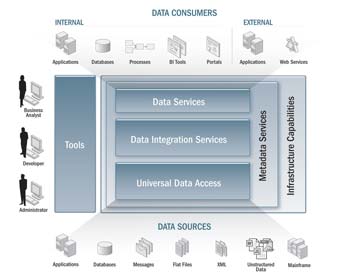LESSON - How to Manage Data Integration across Your Enterprise
The Three Issues Your Organization Can’t Afford to Overlook
By Judy Ko, Director, Enterprise Marketing, Informatica Corporation
Strategic business initiatives often trigger one or more major IT projects—implementing a single view of the customer, synchronizing multiple operational systems to support an end-to-end business process, or consolidating multiple applications to reduce costs. Yet IT organizations often struggle to deliver on business requirements. What’s causing the problem? Data fragmentation.
Data resides in disparate silos throughout the enterprise. The content, quality, structure, and definitions of the data in these silos are as variable as the silos themselves. To ensure that business decisions and operations are based on trustworthy, timely, holistic information, almost every business initiative calls upon IT to access, integrate, and deliver data to the applications and users who need it. In today’s stringent regulatory environment, data also needs to be governed properly to meet the auditing requirements of such regulations as the Sarbanes-Oxley Act.
So what’s the solution? Data integration.
Data integration allows organizations to access all their fragmented data, create an accurate and consistent view of their core information assets, and easily leverage these assets across the enterprise to drive business decisions and operations.
Historically, IT organizations have used a variety of data integration approaches—extract-transform-load (ETL) tools, hand-coded scripts in conjunction with enterprise application integration (EAI), or application vendors’ tools. Over time, this resulted in a proliferation of one-off data integration technologies and complex, brittle IT infrastructures that are costly to manage. As IT organizations take on new initiatives—such as outsourcing a business function—the complexity only increases. To effectively manage data integration across the enterprise, organizations need to look at the problem holistically, taking the following three issues into account:
1. Data and IT architecture
Many IT organizations are adopting service-oriented architecture (SOA), and data integration has an important role to play in that architecture. To increase business agility through loose coupling and reusability of data assets, applications and processes must be able to access business-relevant data—wherever it resides, in whatever form required, whenever it’s needed—consistently and accurately.
2. Organizational approach
Integration competency centers (ICCs) have emerged as a best practice for enterprise data integration. ICCs are an organizational approach designed to increase agility and reduce implementation costs by promoting reuse, sharing best practices and resources, and establishing common processes and standards for integration. ICCs facilitate cross-enterprise collaboration and coordination for global IT teams, including both internal and external resources such as systems integrators and outsourcers.
3. Data integration technology
To support multiple projects with consistency and maximum reuse, to interoperate within dynamic IT environments, and to ensure robust data governance, organizations need a single, unified enterprise data integration platform that offers:
- Broad access to all enterprise data, regardless of type, structure, or source.
- An open, platform-neutral architecture designed for dynamic, heterogeneous IT environments.
- A single, unified architecture to simplify and accelerate development, deployment, and maintenance.
- Enterprise-class security, scalability, reliability, and availability.
- A shared services approach based on metadata and open standards for transparency, interoperability, and flexibility.

Informatica provides a single, unified platform, based on a platform-neutral architecture for data integration across the enterprise.
This article originally appeared in the issue of .